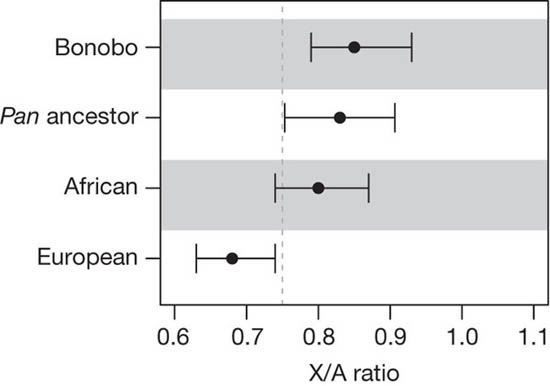The Bonobo Genome Compared with the Chimpanzee and Human Genomes
Kay Prüfer et al., Nature, June 13, 2012
Abstract
Two African apes are the closest living relatives of humans: the chimpanzee (Pan troglodytes) and the bonobo (Pan paniscus). Although they are similar in many respects, bonobos and chimpanzees differ strikingly in key social and sexual behaviours1, 2, 3, 4, and for some of these traits they show more similarity with humans than with each other. Here we report the sequencing and assembly of the bonobo genome to study its evolutionary relationship with the chimpanzee and human genomes. We find that more than three per cent of the human genome is more closely related to either the bonobo or the chimpanzee genome than these are to each other. These regions allow various aspects of the ancestry of the two ape species to be reconstructed. In addition, many of the regions that overlap genes may eventually help us understand the genetic basis of phenotypes that humans share with one of the two apes to the exclusion of the other.
{snip}
Differences in female and male population history, for example, with respect to reproductive success and migration rates, are of special interest in understanding the evolution of social structure. To approach this question in the Pan ancestor, we compared the inferred ancestral population sizes of the X chromosome and the autosomes. Because two-thirds of X chromosomes are found in females whereas autosomes are split equally between the two sexes, a ratio between their effective population sizes (X/A ratio) of 0.75 is expected under random mating. The X/A ratio in the Pan ancestor, corrected for the higher mutation rate in males, is 0.83 (0.75–0.91) (Fig. 4 and Supplementary Information, section 8). Similarly, we estimated an X/A ratio of 0.85 (0.79–0.93) for present-day bonobos using Ulindi single nucleotide polymorphisms in 200-kb windows (Supplementary Information, section 9). Under the assumption of random mating, this would mean that on average two females reproduce for each reproducing male. The difference in the variance of reproductive success between the sexes certainly contributes to this observation, as does the fact that whereas bonobo females often move to new groups upon maturation, males tend to stay within their natal group20. Because both current and ancestral X/A ratios are similar to each other and also to some human groups (Fig. 4), this suggests that they may also have been typical for the ancestor shared with humans.
{snip}
















